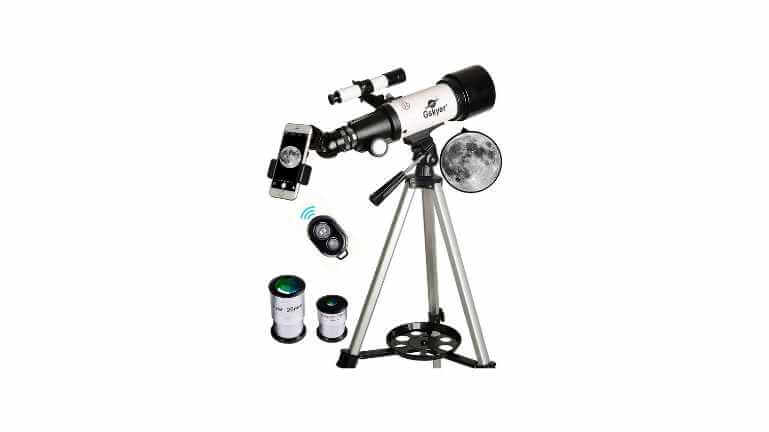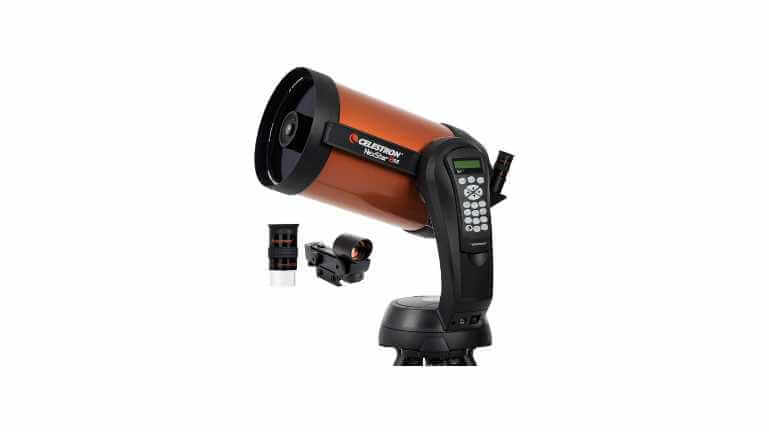Embark on an awe-inspiring journey through the cosmos with the Best Telescope for Viewing Planets. Unlock the wonders of the night sky and witness the beauty of distant worlds with our meticulously curated selection. After extensive research and testing, we’ve identified top-rated telescopes renowned for their exceptional clarity, magnification, and precision optics. Whether you’re an amateur astronomer or a seasoned stargazer, these telescopes offer unparalleled views of planets within our solar system and beyond. From the gas giants to the rocky terrain of Mars, explore the universe in stunning detail with our recommended telescope by your side. Elevate your astronomical pursuits and embark on an unforgettable celestial adventure today.
Gskyer Telescope

Explore the cosmos with the Gskyer Telescope, an astronomical refracting marvel that opens a gateway to the stars. Boasting a 400mm focal length and a 70mm aperture, its fully coated optic glass lens with high transmission coatings delivers breathtaking images while safeguarding your eyes. Immerse yourself in the celestial wonders with two replaceable eyepieces and a 3x Barlow lens that triples the magnifying power. The 5×24 finder scope, complete with cross-hair lines, simplifies object location.
Equipped with a wireless camera remote and a smartphone adapter, this telescope seamlessly blends technology with nature, allowing you to capture celestial beauty effortlessly. The adjustable aluminum alloy tripod and convenient carry bag provide versatile viewing positions and easy portability. Ideal for astronomers on the go, this telescope and tripod effortlessly fit into a compact bag for travel and storage convenience.
Backed by a two-year warranty and round-the-clock technical support from our expert team, the Gskyer Telescope ensures a celestial journey filled with awe and discovery. Elevate your stargazing experience—order now and embark on a cosmic adventure.
Pros:
- High-quality optics with 400mm focal length and 70mm aperture
- Fully coated optics glass lens for stunning images and eye protection
- Two replaceable eyepieces and 3x Barlow lens for versatile magnification
- Wireless camera remote and smartphone adapter for easy celestial photography
- Adjustable aluminum alloy tripod and carry bag for convenient positioning and portability
- 5×24 finder scope with cross-hair lines for efficient object location
- TWO-YEAR warranty and 24-hour technical support for peace of mind
Cons:
- Manual focus may require some adjustment for precise viewing
- Altazimuth mounts might not be as advanced as equatorial mounts for tracking celestial objects
- Limited aperture size may impact the ability to observe fainter celestial bodies
Hexeum Telescope

Enhance your celestial exploration with the Hexeum Telescope! Boasting a substantial optical tube length of 600 millimeters, this telescope is a portal to the cosmos. The 80-millimeter objective lens diameter delivers crisp, detailed views of the night sky.
Unlock the secrets of the universe with optimum magnification using two top-tier eyepieces (25mm and 10mm), offering 24X and 60X magnification. The 3x Barlow lens triples the power, allowing you to marvel at the moon up to 72 or 180 times. Facilitating easy object location, the 5×24 finder scope simplifies your celestial journey.
Portable and convenient, this telescope comes complete with a phone adapter and an adjustable aluminum tripod. Capture breathtaking images effortlessly with the wireless remote control, and when it’s time to explore on the go, the carrying bag ensures seamless portability.
Setting up your cosmic adventure is a breeze with the Hexeum Telescope. No tools are required; it’s quick and easy for novices and experts alike. Enjoy a lifetime of stargazing satisfaction with our commitment to quality and lifetime maintenance. For any inquiries, our dedicated support team is available 24/7. Elevate your astronomical experience with Hexeum!
Pros:
- Two excellent-quality eyepieces (25mm and 10mm) for versatile magnification (24X and 60X).
- The 3x Barlow lens triples magnifying power.
- Portable and convenient with a phone adapter, adjustable tripod, wireless remote, and carrying bag.
- Quick and easy setup with no tools required.
- Lifetime maintenance for long-lasting satisfaction.
- Compatible with smartphones for image capture.
Cons:
- Limited objective lens diameter (80mm) compared to advanced models.
- Altazimuth Mount may have limitations for tracking certain celestial objects.
- Finderscope (5×24) may require adjustment for precise targeting.
- Manual focus may take some practice for optimal results.
- Power source limited to adapter; not ideal for remote locations without power access.
Abotec Telescope

Explore the cosmos with the Abotec Telescope, a stellar companion for enthusiasts and beginners alike. Boasting a 90mm fully multi-coated lens, this telescope captures the wonders of the night sky with enhanced brightness and clarity. Unveil celestial secrets with the 32X–400X high magnification range, revealing lunar craters, Saturn’s rings, and Jupiter’s majesty.
Effortless setup awaits, thanks to the easy-to-follow manual and installation video, making it child’s play for young astronomers. Equipped with 3 eyepieces, a 3x Barlow lens, and a 5×24 finder scope, this telescope ensures an immersive stargazing experience. The included phone adapter and wireless remote open up new horizons for capturing awe-inspiring images.
Transport your telescope with ease using the provided carry bag and adjustable stainless-steel tripod. Stability is key, and the robust tripod, extendable from 28.5 to 45 inches, guarantees a steady view for both adults and kids. Delight budding astronomers or science enthusiasts with this thoughtful Christmas gift that sparks curiosity and exploration.
Embark on a celestial journey with confidence, backed by lifetime maintenance and 24-hour technical support from our expert team. The Abotec Telescope is not just a telescope; it’s a gateway to the universe.
Pros:
- 90mm fully multi-coated lens for enhanced brightness and clarity
- 32X–400X high magnification range for detailed celestial observations
- Easy setup with detailed manual and installation video
- Includes 3 eyepieces, 3x Barlow lenses, and 5×24 finder scope
- Portable design with carry bag and adjustable stainless-steel tripod
- Phone adapter and wireless remote for effortless image capture
- Stable tripod extendable from 28.5 to 45 inches for all ages
- A thoughtful Christmas gift inspires interest in astronomy and science
- Lifetime maintenance and 24-hour technical support for confidence
Cons:
- Smartphone compatibility may vary with different models
Celestron Astromaster 70-Z Telescope

Embark on a celestial journey with the Celestron Astromaster 70 az Telescope, a precision instrument that brings the wonders of the universe to your fingertips. Boasting a sleek 27-inch optical tube length, this telescope offers a panoramic view of the cosmos with its impressive 70-millimeter objective lens diameter. The Altazimuth Mount ensures a quick and tool-free setup, while the pan handle Alt-Az control with clutch guarantees smooth and accurate pointing for an unparalleled stargazing experience.
Featuring erect image optics, this telescope is not only perfect for exploring the night sky but also ideal for terrestrial observation. The quick-release dovetail attachment facilitates hassle-free assembly, making it a user-friendly choice for both beginners and seasoned astronomers. The permanently mounted StarPointer red dot finderscope adds a level of convenience, enhancing your ability to pinpoint celestial wonders effortlessly. With manual focus and an optical lens diameter of 2.6 inches, the Celestron Astromaster 70az Telescope is a reliable companion for enthusiasts who crave a detailed and immersive exploration of the cosmos. Elevate your astronomical pursuits with this extraordinary telescope, where innovation meets simplicity.
Pros:
- Quick and easy, no-tool setup
- Erect image optics for versatile use
- Altazimuth Mount with pan handle control for smooth pointing
- Permanently mounted StarPointer red dot finderscope
- Quick-release dovetail attachment for easy assembly
- Ideal for both terrestrial and astronomical observation
- Compact dimensions: 14.96 inches in diameter, 5.12 inches in width, and 3.94 inches in height
- Manual focus for precise adjustments
- Sturdy construction with an 18-pound weight
Cons:
- Manual focus may require additional attention for beginners
- Limited to 70-millimeter objective lens diameter
- Altazimuth Mount may not suit advanced users seeking equatorial mounts
Celestron Nexstar 8SE

Immerse yourself in the wonders of the cosmos with the Celestron NexStar 8SE Telescope, an awe-inspiring instrument designed for both novice skygazers and seasoned observers. Its sleek orange tube harbors a formidable 8-inch aperture, unlocking the secrets of our solar system with unparalleled clarity. The Schmidt-Cassegrain telescope boasts compatibility with starsense technology and WiFi, offering a modern twist to your celestial explorations.
Navigating the universe has never been easier, thanks to the fully automated go-to mount armed with a comprehensive database of over 40,000 celestial objects. Let the telescope do the work for you, as it automatically locates and tracks celestial wonders. Setting up and breaking down is a breeze with the single-fork arm design and robust steel tripod, facilitated by SkyAlign technology that aligns your telescope swiftly.
Compact yet powerful, this telescope stands at 42.01 inches in diameter, 23.66 inches in width, and 12.99 inches in height. Its manual focus, Plossl eyepiece, and Reflex finderscope add to the versatility of your stargazing experience. Rest easy with Celestron’s unbeatable 2-year warranty and round-the-clock support from a team of US-based experts. Elevate your astronomical adventures with the NexStar 8SE and embark on a journey through the vastness of the cosmos.
Pros:
- 8-inch aperture for exceptional light-gathering capability
- A fully automated go-to mount with a vast celestial object database
- Compact design with easy assembly and breakdown
- Compatibility with Starsense technology and WiFi
- 2-year warranty and reliable customer support from a reputable brand
Cons:
- Manual focus may require adjustment for optimal viewing
- Battery-powered, limiting extended use without replacements
- A steel tripod, while sturdy, adds to the overall weight of transportation
- Limited to the Altazimuth Mount, may not suit all observation preferences
Buying Guide: Best Telescope for Viewing Planets
Exploring the celestial wonders of our solar system has been a fascination for stargazers and astronomy enthusiasts alike. While distant galaxies and nebulae offer breathtaking vistas, there’s something special about observing the planets within our cosmic neighborhood. Each planet presents a unique set of features, from the intricate cloud patterns of Jupiter to the elusive rings of Saturn. To fully appreciate these marvels, a capable telescope is a must-have. In this comprehensive buying guide, we’ll delve into the essential factors to consider when selecting the best telescope for viewing planets.
Telescope Types
Reflector Telescopes
Reflector telescopes, such as Newtonian and Dobsonian designs, are excellent choices for planetary observation. These telescopes employ mirrors to gather and focus light, resulting in a bright and detailed image. Reflectors are known for their high light-gathering capabilities, making them ideal for viewing faint details on planets. The larger the aperture (the diameter of the primary mirror), the more light the telescope can collect, and the better the resolution and contrast of the planetary images.
Refractor Telescopes
Refractor telescopes, which use a lens system instead of mirrors, are also suitable for planetary viewing. These telescopes are renowned for their superior optical quality and color rendition, providing sharp and well-defined images of planets. While refractors generally have smaller apertures compared to reflectors of the same size, they excel in delivering high-contrast and true-to-life planetary views.
Compound Telescopes
Compound telescopes, such as Schmidt-Cassegrain and Maksutov-Cassegrain designs, offer a compact and portable solution for planetary observation. These telescopes combine mirrors and lenses to achieve long focal lengths in a compact body. They provide excellent image quality and are well-suited for both terrestrial and celestial viewing, making them a versatile choice for observing planets and other celestial objects.
Aperture and Focal Length
The aperture, or the diameter of the primary light-gathering component (mirror or lens), is a crucial factor in determining the telescope’s ability to capture fine details on planetary surfaces. A larger aperture allows more light to enter the telescope, resulting in brighter and more detailed images. However, it’s important to strike a balance between aperture size and portability, as larger apertures typically translate to heavier and more cumbersome setups.
The focal length of a telescope also plays a role in planetary observation. A longer focal length provides higher magnification, which can be beneficial for studying intricate features on planets. However, too high a magnification can also amplify atmospheric turbulence, compromising image quality. It’s generally recommended to aim for a focal length that allows comfortable viewing and enough magnification to reveal planetary details without sacrificing image stability.
Mounts and Tracking
To enjoy a steady and enjoyable planetary viewing experience, a stable and smooth-operating mount is essential. Equatorial mounts are designed to follow the apparent motion of celestial objects across the night sky, allowing for prolonged observation without the need for frequent adjustments. Alternatively, alt-azimuth mounts offer a simpler and more user-friendly setup, but may require periodic adjustments to keep the planet centered in the eyepiece.
For those interested in astrophotography or long-exposure observations, a tracking mount can be invaluable. These mounts are equipped with motors that automatically follow the motion of celestial objects, ensuring sharp and detailed images or video footage.
Eyepieces and Accessories
Eyepieces play a crucial role in determining the magnification and field of view of your telescope. For planetary observation, a range of eyepieces with different focal lengths can be beneficial, allowing you to explore different levels of detail and overall views. High-quality eyepieces with superior optical coatings and wide fields of view can greatly enhance your observing experience.
Additional accessories, such as filters and barlows, can further enhance your planetary viewing experience. Color filters can help enhance contrast and bring out specific details on planetary surfaces, while barlows can increase the effective magnification of your eyepieces, allowing you to zoom in even closer on planetary features.
Conclusion
Choosing the best telescope for viewing planets requires a careful consideration of various factors, including telescope type, aperture, focal length, mounts, and accessories. By taking into account your specific needs, observing preferences, and budget, you can make an informed decision that will unlock the wonders of our solar system’s planets. Remember, the key to a rewarding planetary observing experience lies in finding the right balance between optical quality, portability, and ease of use. With the right telescope and accessories, you’ll be well-equipped to embark on an extraordinary journey through our celestial neighborhood.
Frequently Asked Question
What type of telescope is best for observing planets?
The best type of telescope for observing planets is a refractor telescope with a large aperture. Refractors use lenses to gather and focus light, providing sharp and high-contrast images of planets. Telescopes with larger apertures (the diameter of the objective lens or mirror) allow more light to enter, enhancing the details visible on planets.
What is the ideal aperture size for a planetary telescope?
For observing planets, an ideal aperture size is around 4 inches (100 mm) or larger. A larger aperture gathers more light, revealing finer details on the planets’ surfaces and improving overall image quality. However, factors like portability and budget should also be considered when determining the right aperture size for your needs.
Can I use a telescope with high magnification for planetary viewing?
While magnification is important, balancing it with the telescope’s aperture is equally crucial. High magnification without a sufficient aperture can result in dim and blurry images. A good rule of thumb is to use a magnification of 50x to 60x per inch of aperture. For example, a 4-inch telescope can comfortably handle 200x to 240x magnification for planetary observations.
What additional accessories enhance planetary viewing?
Accessories like high-quality eyepieces, a stable mount, and a Barlow lens can enhance planetary viewing. Premium eyepieces with good eye relief and coatings make for clearer and brighter images. A sturdy mount ensures stability, preventing image shake. A Barlow lens can effectively double or triple the telescope’s magnification, providing versatility for observing different planetary details.
Are there specific features to look for in a planetary telescope?
Look for telescopes with good optics, preferably featuring high-quality glass and coatings to maximize light transmission. Like an equatorial or alt-azimuth mount, a sturdy mount is essential for smooth tracking and precise adjustments during planetary observations. Additionally, a telescope with a motorized tracking system can be advantageous for keeping planets in view for extended periods, especially during high-magnification observations.

Mark is a seasoned Outdoor Equipment and Heating Appliances specialist. With a passion for adventure and a keen understanding of heating solutions, he brings expertise to the world of outdoor enthusiasts. Mark’s insights, gained through years of experience, make him a go-to resource for those seeking reliable guidance in navigating the realm of outdoor gear and heating technologies.
